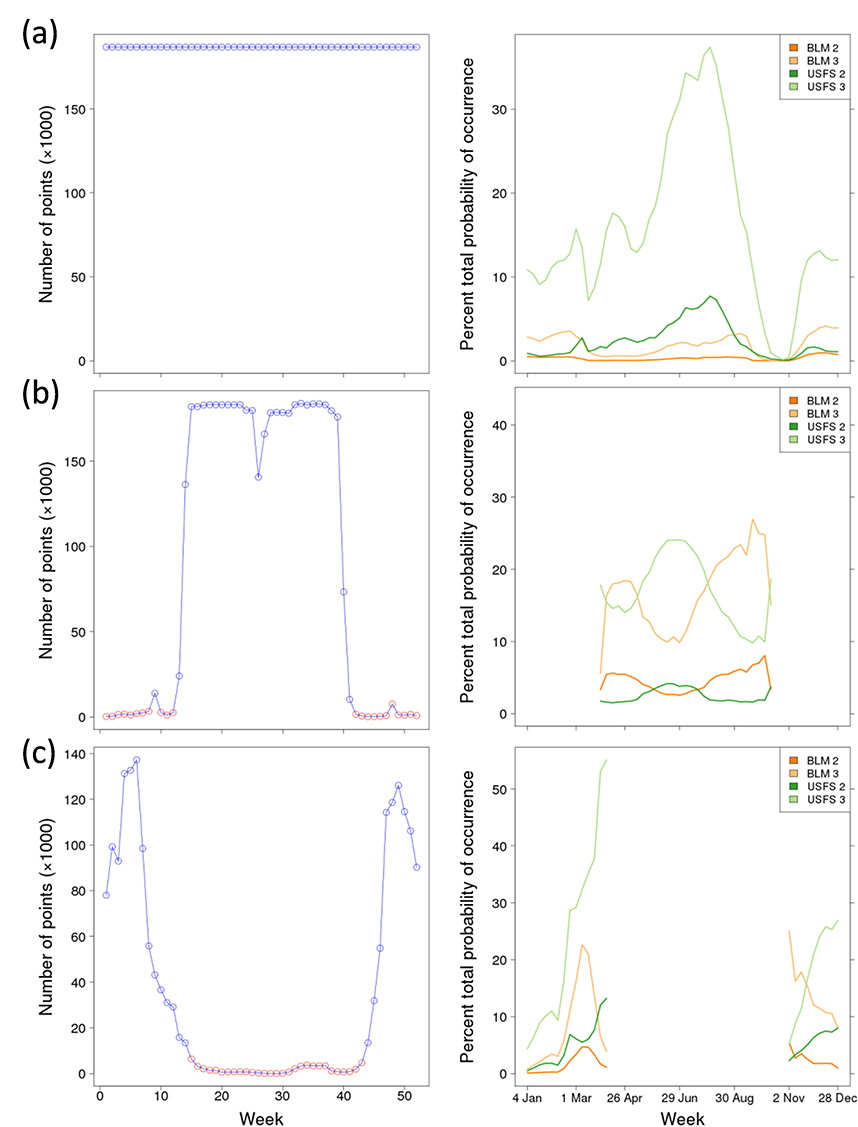
Ecological Archives A025-004-A2
Frank A. La Sorte, Daniel Fink, Wesley M. Hochachka, Jocelyn L. Aycrigg, Kenneth V. Rosenberg, Amanda D. Rodewald, Nicholas E. Bruns, Andrew Farnsworth, Brian L. Sullivan, Chris Wood, and Steve Kelling. 2015. Documenting stewardship responsibilities across the annual cycle for birds on U.S. public lands. Ecological Applications 25:39–51. http://dx.doi.org/10.1890/14-0702.1
Appendix B. Supporting figures displaying examples of species’ weekly frequency of occurrence and weekly stewardship plots; weekly occurrence centroids and average breeding season probability of occurrence on GAP status 2 lands; weekly occurrence centroids and average breeding season probability of occurrence on GAP status 3 lands; and weekly elevation associations and maximum seasonal range size.
Fig. B1. Three examples of weekly frequency of occurrence plots (number of 3-km points with probabilities >0; left column) and the weekly total percent probability of occurrence on BLM and USFS lands designated as GAP status 2 or 3 (right column). The examples are (a) American robin (Turdus migratorius), (b) black-headed grosbeak (Pheucticus melanocephalus), and (c) bohemian waxwing (Bombycilla garrulus), which are classified as year-round, summer, and winter, respectively. The blue circles in the frequency plots are weeks that were retained for analysis, and the red circles are weeks that were removed from analysis due to low sample sizes within the study area.
Fig. B2. Weekly occurrence centroids (colored points) and average breeding season probability of occurrence (grayscale) for Year-round (n = 214) and Summer species (n = 75) and average non-breeding season probability of occurrence (grayscale) for Winter species (n = 19) on GAP status 2 lands administered by the Bureau of Land Management (BLM) and the United States Forest Service (USFS). Species groups were identified based on a hierarchical cluster analysis of species' weekly stewardship relationships, implemented on public lands west of the 98th meridian administered by the BLM and USFS and designated as GAP status 2 (see Methods for details). Breeding season is defined as the three week period centered on July 5th and non-breeding season is defined as the three week period centered on February 1st.
Fig. B3. Weekly occurrence centroids (colored points) and average breeding season probability of occurrence (grayscale) for Year-round (n = 214) and Summer species (n = 75) and average non-breeding season probability of occurrence (grayscale) for Winter species (n = 19) on GAP status 3 lands administered by the Bureau of Land Management (BLM) and the United States Forest Service (USFS). Species groups were identified based on a hierarchical cluster analysis of species' weekly stewardship relationships, implemented on public lands west of the 98th meridian administered by the BLM and USFS and designated as GAP status 3 (see Methods for details). Breeding season is defined as the three week period centered on July 5th and non-breeding season is defined as the three week period centered on February 1st.
Fig. B4. (top row) Elevations estimated weekly for the combined period 2004 to 2011 and averaged across species by seasonal guild (Year-round, Summer, Winter) and stewardship cluster (1, 2, 3) on public lands west of the 98th meridian administered by the Bureau of Land Management (BLM) and the United States Forest Service (USFS) designated as GAP status 2 or 3. (bottom row) Maximum geographic extent west of the 98th meridian (proportion of SRD points) estimated for the combined period 2004 to 2011and summarized by seasonal guild and stewardship cluster.